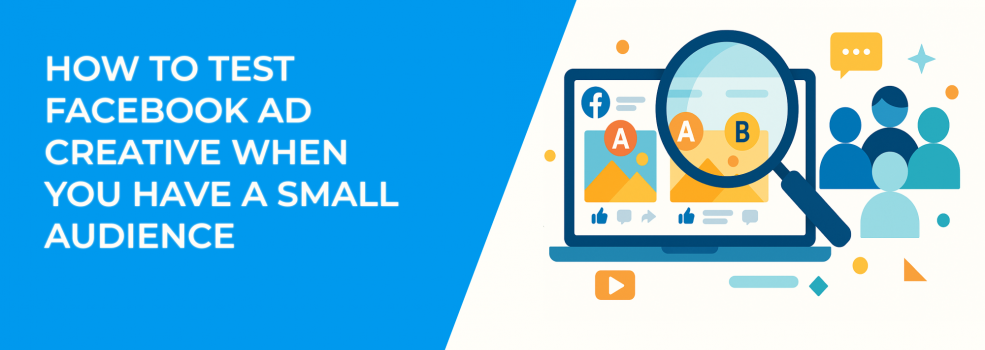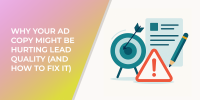Testing Facebook ad creative is one of the most critical levers in improving campaign performance. Yet for advertisers working with a small audience — such as niche B2B segments, local markets, or highly filtered customer lists — effective testing can feel out of reach.
Without scale, you can’t rely on traditional multivariate tests. You don’t have the luxury of wasting impressions. And your data? It takes longer to become statistically reliable.
But that doesn’t mean creative testing is out of the question. Far from it.
This guide breaks down how to structure a lean, high-signal Facebook ad testing strategy even when your audience is small and your budget is tight.
Why Creative Testing Is Still Essential (Even With Limited Reach)
If your audience is under 10,000 people, you may be tempted to rely on best practices and skip testing altogether. But creative performance varies drastically from campaign to campaign. What works in one context can underperform badly in another.
Your creative determines:
-
Whether people notice your ad.
-
How clearly they understand your offer.
-
Whether they take action (click, sign up, purchase).
A well-tested headline or image can improve performance by 30% to 100% — and in small-audience campaigns, that margin can make the difference between breakeven and scale.
The Core Challenge: Small Sample Size, Slower Feedback
When you’re targeting a limited audience, two constraints define your testing environment:
-
Low impression volume — Your ads aren’t served frequently enough to produce statistically significant results quickly.
-
Algorithmic inefficiency — Facebook's delivery system can’t optimize effectively when ad sets compete for the same small pool of users.
In other words, you need to test differently. Precision and patience replace speed and scale.
Strategy 1: Test Sequentially, Not in Parallel
Avoid running multiple ad creatives simultaneously within the same ad set. When you split impressions across several versions, each creative gets too little exposure to deliver meaningful insights.
Instead:
-
Start with one control creative.
-
Run it for a fixed period (e.g., 3–5 days depending on budget).
-
Evaluate based on early indicators like CTR, engagement rate, and video watch time.
-
Replace with one variation at a time.
By running tests sequentially, you eliminate competition between creatives and maintain tighter control over learning variables.
Tip: maintain consistent budgets, placements, and schedule settings to isolate creative performance. Avoid introducing new variables mid-test.
Strategy 2: Use Broad or Lookalike Audiences for Initial Testing
When possible, test ad creatives with a broader, more algorithm-friendly audience. This could be:
-
A 1% lookalike audience based on your best customers.
-
A broad interest-based segment aligned with your niche.
-
A custom audience of past website visitors or high-intent users.
This approach gives Facebook’s algorithm more room to learn and helps you collect engagement signals faster. Once you’ve identified your top-performing creative, you can apply it confidently to your smaller, high-value audience.
Important: don’t evaluate creative performance in isolation. Always link it to your campaign goal whether that’s traffic, leads, or purchases.
Not sure whether to use a custom or lookalike audience for testing? Here’s how to decide what works best for Facebook campaigns.
Strategy 3: Focus on Micro Metrics That Guide Creative Refinement
When conversion volume is low, you need to rely on upstream signals to assess performance.
Monitor:
-
CTR (Click-Through Rate): Indicates how compelling your creative is at generating interest.
-
3-Second Video Views / Impressions: A proxy for scroll-stopping power in video ads.
-
Engagement Rate: Reactions, comments, and shares offer qualitative insight into how your message resonates.
-
Landing Page Bounce Rate: If clicks are high but bounce rates are also high, your creative might be overpromising or misaligned.
How to use this data: suppose a creative gets a strong CTR but weak engagement. That could suggest curiosity without clarity. If engagement is high but conversions are low, your offer may lack urgency. Use these insights to refine headlines, calls-to-action, and imagery.
Strategy 4: Use the Minimum Viable Testing Framework
With limited data, your testing process must be simple, structured, and replicable. Use this “minimum viable test” framework:
-
Test one variable at a time — such as the headline, main image, or CTA.
-
Run A/B comparisons with only two versions at any given time.
-
Use fixed budget caps to limit overspend (e.g., $20–$50 per variation).
-
Set evaluation timelines (typically 3–7 days depending on volume).
By simplifying the test setup, you remove ambiguity from your learnings and prevent decision fatigue.
Tip: document your test results and hypotheses. Build a repository of what works over time, especially for specific audience segments.
If you're looking to deepen your understanding of structured testing, explore these key strategies for Facebook ad testing that work across both small and large-scale campaigns.
Strategy 5: Pre-Test Creatives Using Organic Content
If your brand has an active Facebook or Instagram presence, use it to test creative concepts before launching paid campaigns.
Post your creative options organically and monitor:
-
Engagement volume and rate.
-
Comment sentiment (e.g., confusion, interest, excitement).
-
Share rate or saves (on Instagram).
These soft signals often mirror paid performance trends. If one version consistently outperforms others in an unpaid setting, it’s a strong candidate for your ad test.
This strategy is particularly useful for testing:
-
Different tone of voice (conversational vs. formal).
-
Hook ideas for headlines.
-
Visual design styles (minimalist, UGC-inspired, bold color use).
It’s a low-risk, high-signal way to validate concepts before putting ad spend behind them and an excellent habit for ongoing creative iteration.
Strategy 6: Lean Into Native, Lo-Fi, or UGC-Style Ads
Small audiences tend to respond better to authentic, lower-production-value creative — particularly in B2B, local, or high-trust contexts.
Consider:
-
Selfie-style video explainers.
-
Testimonials recorded on mobile phones.
-
Unpolished graphics with clear text overlays.
-
Behind-the-scenes shots of your team, process, or workspace.
These formats often outperform traditional branded ads, especially when your goal is connection rather than scale.
Why it works:
These assets feel native to the platform. They blend into users’ feeds and lower resistance, making your message feel more genuine and less “salesy.”
Want to experiment with UGC but unsure where to start? Learn how to use authentic, user-generated content in your ads to boost credibility and performance.
Strategy 7: Budget Intelligently — Allocate for Learning
Creative testing does require investment. If your total campaign budget is $1,000 per month or less, reserve 15%–20% for testing. That translates to $150–$200 monthly, or roughly $50 per test cycle.
Set clear test goals:
-
Are you validating a new messaging angle?
-
Comparing static vs. video?
-
Testing a new offer format?
And use fixed spend limits to maintain predictability.
Caution: don’t cut your main conversion campaigns to fund testing — the goal is to improve future performance, not compromise today’s results.
Also, your testing success also depends heavily on choosing the right campaign objective — get clarity on which to use with this guide to Meta ad objectives.
A Quick Note on Facebook’s A/B Testing Tool
Facebook’s built-in “Experiments” feature is designed for statistically rigorous testing, but it assumes you have a large enough audience to split meaningfully.
For most small-audience advertisers, this tool isn’t ideal.
Manual testing using sequential ad sets gives you greater control and more reliable signals in low-volume environments. Once your campaigns scale, you can introduce native A/B testing tools with cleaner audience splits.
Final Thoughts: Testing in a Constrained Environment
Testing Facebook ad creative with a small audience isn’t about volume — it’s about intent.
You’re not optimizing for every possible variation. You’re focusing on what matters most: clarity, resonance, and action.
Here’s a recap of what works:
-
Test fewer things, more deliberately.
-
Let micro metrics guide creative decisions.
-
Use broader audiences or organic posts for faster feedback loops.
-
Favor clear, human, authentic visuals over polished design.
-
Track learnings to build a creative performance playbook over time.
Ask yourself: is your creative clear enough to drive action? Is your message believable, relevant, and easy to grasp?
If you’re not getting results, don’t scale — refine.
A small audience shouldn’t be a barrier to performance. With the right testing strategy, it can be a strategic advantage.

